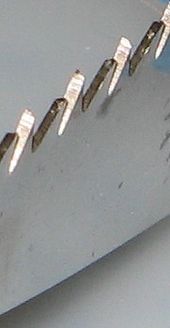Set (saw)
In the case of saw blades, set is the bending of the teeth alternately to the right and left.
function
So that a saw does not get stuck in the cut, but rather cuts itself free , the saw cut must be wider than the blade. Contraction is one of several ways to achieve this. The teeth are bent alternately to the left and right at a third to half of their height (crossed against each other). The overhang must be the same on both sides, otherwise the saw will wear unevenly and run.
The height and width of the set depend on the purpose of the saw. For example, the precision saw and offset saw are set only slightly for a clean and fine cut and good guidance, while the cutoff saw and chopping saw for high cutting performance are wide.
There are various hand tools for setting new saw blades for the first time, for setting individual bent teeth or for setting the entire saw. Setting has to be done before sharpening. Saws with hardened saw blades or teeth cannot be re-set as the teeth will then break off. In industrial production, saw blades are set using machines.
Setting tools
Bending iron
Bending irons consist of a steel plate with a handle. The plate has incisions of different sizes for different tooth sizes, with which the teeth are gripped and bent. Since even setting with the setting iron requires some experience, there are versions with stops where the setting width can be adjusted.
Setting pliers
In the case of setting pliers, the depth of engagement and the deflection can be fixed using stops and adjusting screws. With them, the saw blade is gripped by the tooth and this is bent out when the pliers are closed.
Web links
Individual evidence
- ↑ a b c Wolfgang Nutsch and others; Expertise for carpenters , 12th edition, Verlag Europa-Lehrmittel OHG, Wuppertal 1980, page 236, ISBN 3-8085-4011-7
- ^ Theodor Krauth and Franz Sales Meyer: The joiner's book Ⅰ The building joinery Ⅰ. Volume: Text , published by EA Seemann, Leipzig 1899, reprint edition "Libri rari" Th. Schäfer GmbH, Hanover 1981, page 21
- ↑ saw . In: Meyers Großes Konversations-Lexikon . 6th edition. Volume 17, Bibliographisches Institut, Leipzig / Vienna 1909, pp. 417–418 .



